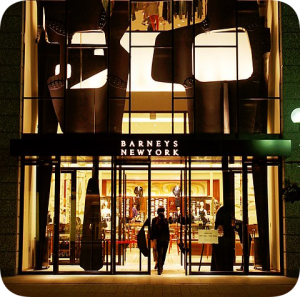 Last week, we took a look at how online shopping and rising rents are causing many retailers to reassess the worth of their flagship stores. Among the companies mentioned was Barneys, a Manhattan mainstay that used the success of its nine-story flagship to expand across the world. The retailer first became famous for its flashy Madison Avenue window displays that drew countless people inside over the years. By the late 1990s, Barneys became an almost sacred destination for shoppers thanks to its frequent appearances on the HBO show Sex and the City.
Last week, we took a look at how online shopping and rising rents are causing many retailers to reassess the worth of their flagship stores. Among the companies mentioned was Barneys, a Manhattan mainstay that used the success of its nine-story flagship to expand across the world. The retailer first became famous for its flashy Madison Avenue window displays that drew countless people inside over the years. By the late 1990s, Barneys became an almost sacred destination for shoppers thanks to its frequent appearances on the HBO show Sex and the City.
But as the 2000s gave way to the 2010s, Barneys steadily lost its appeal with upscale consumers as well as curious tourists. Along with dwindling foot traffic, the retailer also faced higher rent with each passing year. Unlike companies like Saks, Barneys does not own the property for its flagship location. So there was little the retailer could do in 2018 when an arbiter ruled that the rent on its Madison Avenue store would be raised from $16 million to $30 million. This ruling put Barneys into an almost impossible bind: with more than $300 million in annual sales, the flagship store accounted for a third of its revenue. At the same time, the enormously high rent was preventing the company from generating any profit.
Even worse, sales at the Madison Avenue location have been been falling for the last year and a half. Barneys sought outside investment to offset these losses but couldn’t find anyone willing to take the risk. That’s why on Monday the retailer announced it would file for bankruptcy protection in order to restructure its business. While the Madison Avenue location will remain open, Barneys will close 15 of its 22 locations in major metropolises like Chicago, Seattle, and Las Vegas. “Our goal is to continue serving our customers in key flagship markets and globally through Barneys.com for the long term,” said CEO Daniella Vitale. “While difficult decisions had to be made, this process will allow us to reset our financial position and maintain our longstanding vendor relationships.”
Questions:
- How did Barneys grow to become a major name in retail? What factors contributed to its decline?
- Do you think Barneys’ flagship store will be able to survive in the long term? Why or why not?
Sources: Vanessa Friedman and Michael J. de la Merced, “Barneys, Global Symbol of Creative Cool, Files for Bankruptcy,” The New York Times, August 6, 2019. Photo by 663highland.
